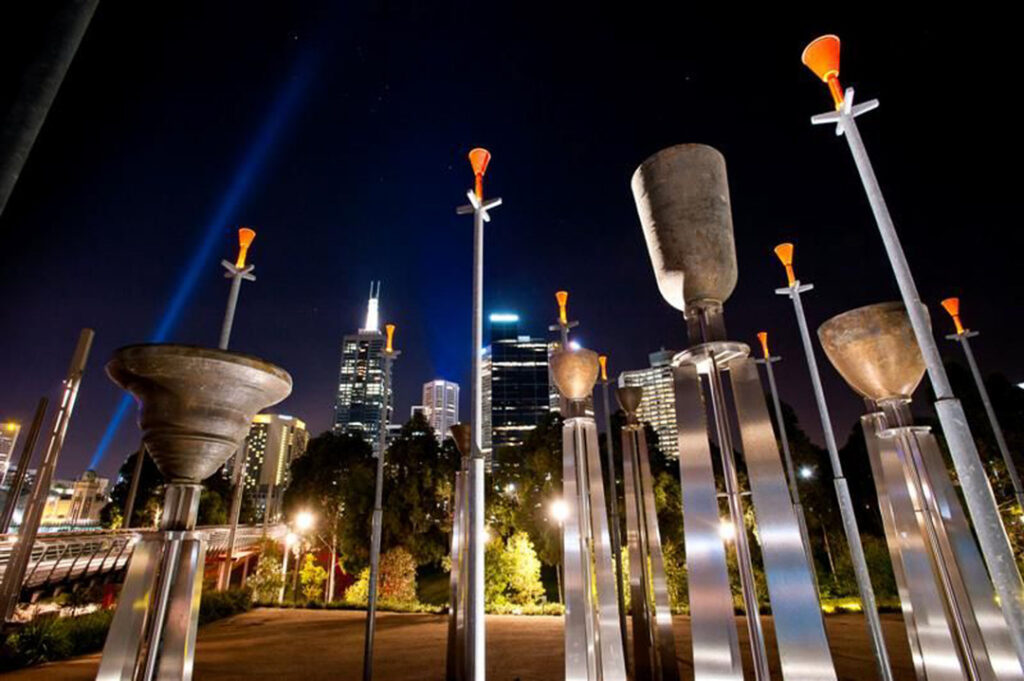Anton Hasell draws on the auditory heritage of cathedrals to fabricate bells that will resonate into the distant future.
I have marvelled at the huge interior of Chartres Cathedral, a vivid site of multi-sensory experience’, brilliantly lit by the South Rose stained-glass window.
I’ve listened, enthralled, to the pure voices of a boy-choir resonant in the soaring architectural volumes of York Cathedral. I have been moved by the one thousand and one statues of Kannon-Bosatsu in the temple hall called Sanjusangendo, in Kyoto. Experiencing sacred sites around the world rediscovers my archetypal feelings for communities of individuals, in spaces, made complete, in their vibrant response to life’s mysteries, its ineffable and unutterable majesty.
In places of multi-sensory experience such as these, visitors transform from spectators into participants. The idea of an individual resonates and swells, filling the space with feelings for the communal.
I cast and tune bells for traditional sacred sites. I also design public-space musical bell installations for secular societies seeking community-building experiences. If sustainable futures are to be negotiated, it requires, at least, that the perceived interests of individuals be brought into tune with community interests. (fig1) tuning bell in studio foundry.
The Federation Bells Installation represents a new kind of twenty-first-century public artwork. It uses new design bells, a craft of ancient origin, reinvented with technology, to continue the bell’s calling-together community function. Bell founders have always been first-responders to available technology, given the casting precision that musical sound requires. Computer-designed new musical bells, never-the-less, are fine-tuned by hand. The Federation Bells Installation’s musical set of 39 bells can be composed by anyone, anywhere, in the world, either through its webpage or by the free downloadable phone app. This is a public artwork that enables, and encourages, people to come together to share their creative cultural playfulness with others. Its changing, renewable site experience is accessible, and the interactive, participatory and communal functions are by design.
Clocks and bells have a paradoxical relationship. The interrupted, stop-start clock escapement is a metronomic see-saw segmenting the flow of liquid time. A bell’s ring ripples across space, slowly waning in amplitude, toward silence. A duration of transcendent, elastic and malleable time. Yet bells have voiced clocks for hundreds of years. Perhaps in opposition, together, they give a better sense of time’s essential tempestuousness.
In 2013 Danny Hillis, designer of the 10,000-Year Clock, asked me if it was possible to invent a difference-tone bell. Small pipe organs use difference-tones to simulate lower pitches that require pipe lengths not available to them. By playing a pipe with its perfect fifth pipe audiences will hear a pitch an octave below the pipe’s natural note, a psychoacoustic pitch from a pipe half the usual length. Brian Eno’s mixolydian scale for the 10 clock bells, plus the constricted space inside the mountain, called for smaller than normal bells. Was a difference-tone bell, at half scale, possible?
Working with Ryan Adams using Professor Thomas’ Finite Element Analysis (FEA) software ‘ReShape’, we optimised a CAD virtual model that predicted a difference-tone pitch. Cast into bronze, however, the bell failed to sound a difference-tone. Encouraged by Danny Hillis, further research was undertaken to tune the bell’s profile by hand until it did generate a difference-tone. The newly invented bell rung a pitch an octave below any partial-frequency in the bell itself, at half a normal bell’s size.
Australia Bell was then commissioned to cast and tune the ten bells for the 10,000-Year Clock, and ship them to the USA from Victoria, Australia. The bells will ring a non-recurring pattern over the next 10,000 years. Within the mountain, the clock counts binary time in a delicate balance with each bell’s elastic time-space audition.
In 2017 I was awarded an ANAT Synapse Research Fellowship to work with Dr Daniel East at the CSIRO’s Lab 22 3D printing in metals. The resulting research was published in Leonardo as ‘The acoustics of 3D printed metal bells’, (August 2021). This research work is ongoing, with new bell designs and manufacturing processes being explored to bring bell design into the twenty-first century.
A 3D-printed stainless-steel difference-tone bell was included in the Experimenta Living Forms Triennial exhibitions that toured around Australian public galleries between 2021 and 2023.
The Japanese poet Basho speaks to the re-ordering of perception a bell’s sound envelops people within. He wrote
“Who said there were only eight views of Biwa?
The ninth view is the sound of Mii-dera’s bell”.
Price, Bells and Man Oxford University Press, 1983, p. 49
Perhaps this partly explains the place of bells in sacred sites across Europe and Asia. Technology makes possible new public-space bell experiences for current, and future, contemporary urban design’s community-building acoustic overlay.
The art, craft, design, technology and science of bell invention and manufacture have an important place in both temples and public-space galleries as contributors to sustainable, livable, socially cohesive communal habitats for the twenty-first century, and beyond.
About Anton Hassel
 Dr Anton Hasell is a professional artist living in Central Victoria, Australia. He is known for creating the Federation Bells Carillon in Melbourne and the 10 Difference-Tone bells in the 10,000-Year Clock project in the USA, amongst many other public-space artworks. His research explores craft traditions and contemporary technology in the creation of interactive and participatory public-space artworks accessible to everyone in the community that encourage individual within the site together to share their creative imagination and creativity with others.
Dr Anton Hasell is a professional artist living in Central Victoria, Australia. He is known for creating the Federation Bells Carillon in Melbourne and the 10 Difference-Tone bells in the 10,000-Year Clock project in the USA, amongst many other public-space artworks. His research explores craft traditions and contemporary technology in the creation of interactive and participatory public-space artworks accessible to everyone in the community that encourage individual within the site together to share their creative imagination and creativity with others.






